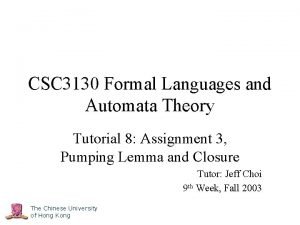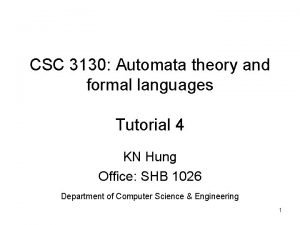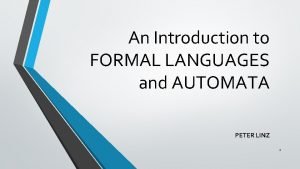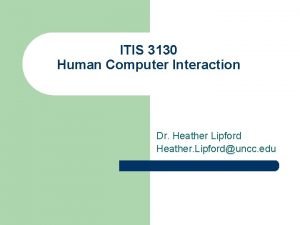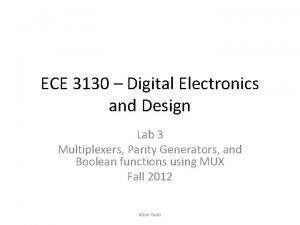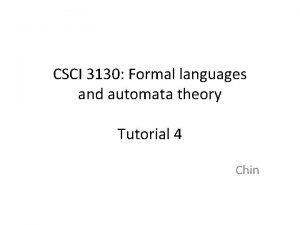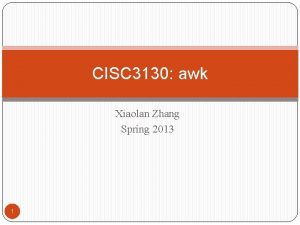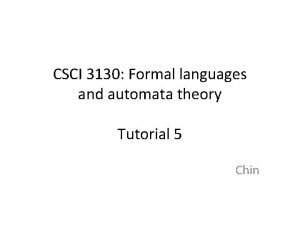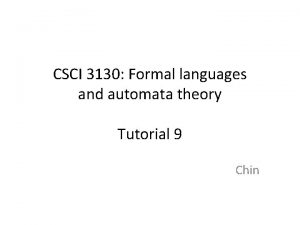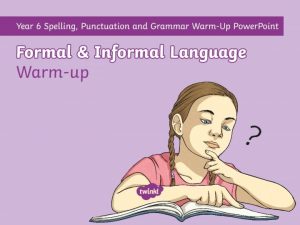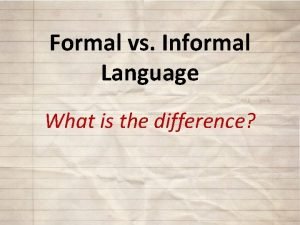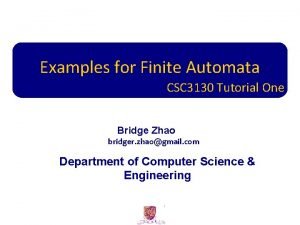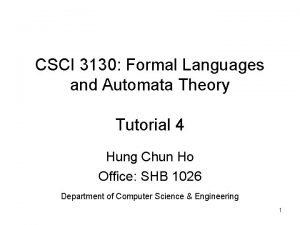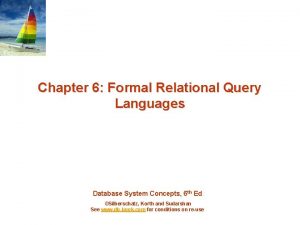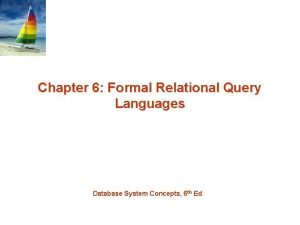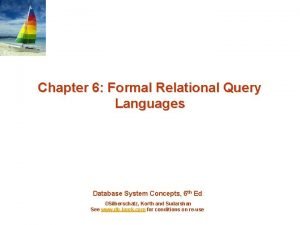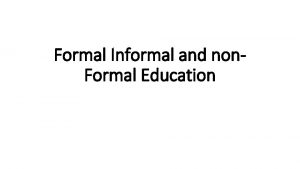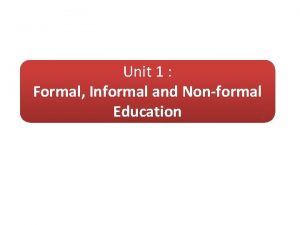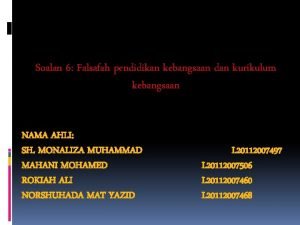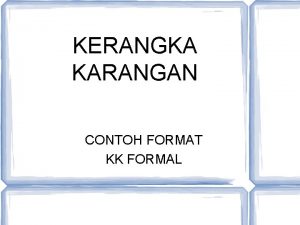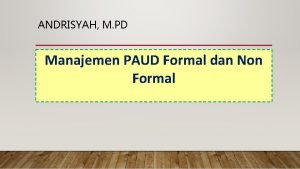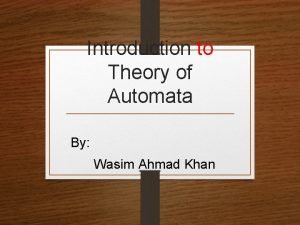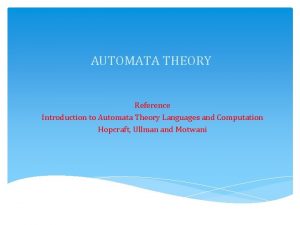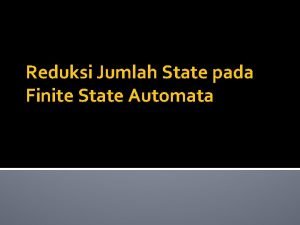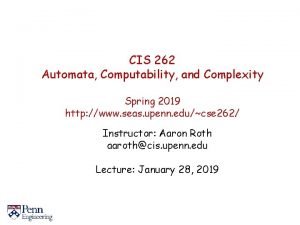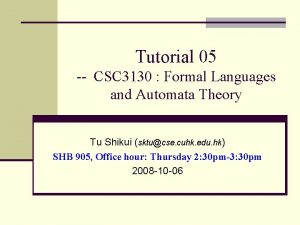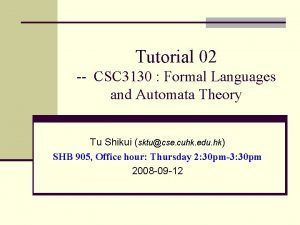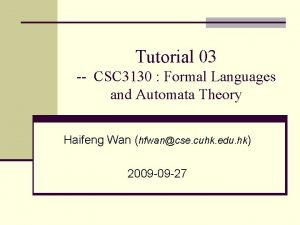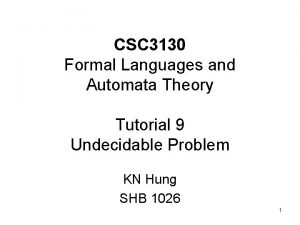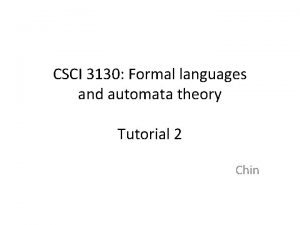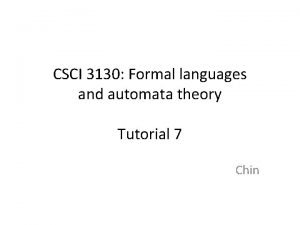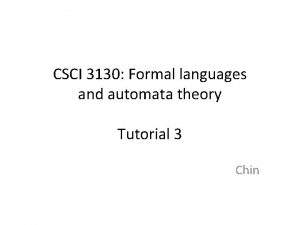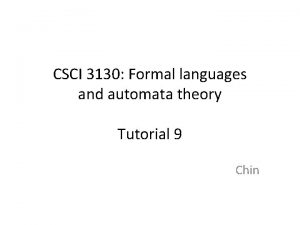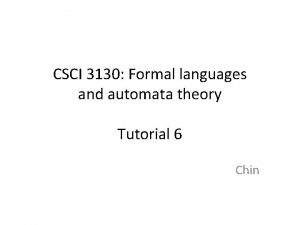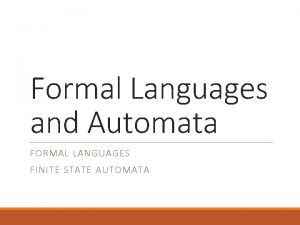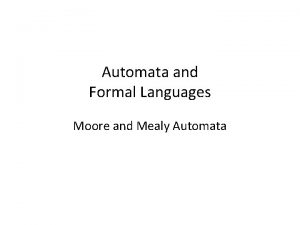Tutorial 03 CSC 3130 Formal Languages and Automata




































- Slides: 36

Tutorial 03 -- CSC 3130 : Formal Languages and Automata Theory Haifeng Wan (hfwan@cse. cuhk. edu. hk) 2009 -09 -27

Outline n Pumping Lemma n DFA Minimization n Context-free Languages

Pigeonhole Principle n Pigeonhole principle n If m objects are put into n containers, where m>n, then at least one container must hold more than one object. n The pigeonhole can be used to prove that certain infinite languages are not regular. n Remind: any finite language is regular.

Pumping Lemma for Regular Languages n Theorem: For every regular language L There exists a number n such that for every string z in L, we can write z = uvw where |uv| ≤ n |v| ≥ 1 For every i ≥ 0, the string u vi w is in L. z … u v … w

Pumping Lemma n What does the Pumping Lemma say? n If an infinite language is regular, it can be defined by a DFA. n The DFA has a finite number m of states. n Since the language is infinite, some strings of the language must have length greater than m. n For a string of length greater than m accepted by the DFA, the walk through the DFA must contain a cycle. n Repeating the cycle an arbitrary number of times must yield another string accepted by the DFA. n Remind: the Pumping Lemma is not sufficient. n It is one way to prove that a given infinite language is not regular, while it cannot be used to prove that a given infinite language is regular.

Outline to Prove by Pumping Lemma n Main idea: prove by contradiction. n Brief outline: n Assume the language L is regular (and thus the Pumping Lemma holds). n Show that repeating the cycle some number of times (“pumping” the cycle) yields a string that is not in L. n Conclude that L is not regular by contradiction. n What can we think about during using Pumping Lemma? n n On choosing the particular string z in L. On choosing the number of times to “pump” the cycle.

Example 1 n Prove that L 3={uu: u in {0, 1}*} is not regular. n Suppose L 3 is regular, there exists n n Choose a string z=0 m 1 with m>n, n Although the decomposition of z into uvw is unknown, uv must consist entirely of 0 s because |uv|≤n. Moreover, |v|≥ 1. Simply choose i=2. Thus uv 2 w will have more 0 s before the first 1 than the second 1, which is not in L 3. Thus L 3 is not regular due to the contradiction. n n

Example 2 n Prove that L={x: x has different numbers of 0 s and 1 s} is not regular. n Trick: n Instead of directly prove this, let’s prove its dual stated language D={x: x has the same number of 0 s and 1 s} is not regular. n Steps: n Remind that we have proven L={0 n 1 n: n≥ 0} is not regular. And L = D n n If L is regular, then D should also be regular. Thus D is not regular according to the contradiction. Neither is L. .

n Take x = 0^n 1^{n! + n}. n Then the adversary splits it as uvw. Let k be the length of the v part. n Now pump it (n!+k)/k times. n Then you get uv^iw = 0^{k((n!+k)/k) + (n- k)}1^{n!+n} = 0^{n! + n}1^{n! + n}

Example n Prove that n n n L 2 ={1 m: m is prime} is not regular. Suppose L 2 is regular, and thus Pumping Lemma holds. Although n is unknown, we can still assume that there is one. Choose a string z=1 m where m is a prime number and |uvw|=m>n+1. Any prefix of z consists entirely of 1 s. Although the decomposition of z into uvw is unknown, it follows that |w|>1 due to |uvw|> n. Moreover, |v|≥ 1. Choose i=|uw|. (Remind |w|>1 and |uw|>1). We have |u vi w|=|uw|+|v||uw|=(1+|v|)|uw|. Because both 1+|v| and |uw| are greater than 1, the product must be a composite number, i. e. , |u vi w| is a composite not a prime number. It is not in L 2. Thus, L 2 is not regular due to the contradiction. Q. E. D.

Outline n Pumping Lemma n DFA Minimization n Context-free grammars (CFG)

DFA Minimization n There is an algorithm to start with any DFA and reduce it to the smallest possible DFA n The algorithm attempts to identify classes of equivalent states n These are states that can be merged together without affecting the answer of the computation

Equivalent and Distinguishable States n Two states q, q’ are equivalent if ^ d(q, w) and ^ For every string w, the states d(q’, w) are either both accepting or both rejecting ^ w) is the state that the machine is in n Here, d(q, if it starts at q and reads the string w n q, q’ are distinguishable if they are not equivalent: For some string w, one of the states d(q, w), d(q’, w) is accepting and the other is rejecting

DFA Minimization Algorithm n Find all pairs of distinguishable states as follows: For any pair of states q, q’: If q is accepting and q’ is rejecting Mark (q, q’) as distinguishable Repeat until nothing is marked: For any pair of states (q, q’): For every alphabet symbol a: If (d(q, a), d(q’, a)) are marked as distinguishable Mark (q, q’) as distinguishable For any pair of states (q, q’): If (q, q’) is not marked as distinguishable Merge q and q’ into a single state

Example 1 0 q 1 0 1 q 2 1 0 q 3 q 0 0, 1 q 4 1 q 2 q 3 q 4 q 0 q 1 q 2 q 3 q 4

Example 1 (cont. ) 0 q 1 0 1 q 2 1 0 q 3 0, 1 q 4 1 q 2 q 3 q 4 x x q 0 q 1 q 2 q 3 q 4 is distinguishable from all other states

Example 1 (cont. ) 0 q 1 0 1 q 2 1 0 q 3 0, 1 q 4 1 q 2 q 3 q 4 x x x x q 0 q 1 q 2 q 3 q 0 is distinguishable from q 1, q 2, q 3, q 4

Example 1 (cont. ) 0 q 1 0 1 q 2 1 0 q 3 0, 1 q 4 1 q 2 q 3 q 4 x x B B x x q 0 q 1 q 2 q 3 Merge states not marked distinguishable q 0 cannot be merged → group A q 1, q 2, q 3 are equivalent → group B q 4 cannot be merged → group C

Example 1 (cont. ) B A 0 q 1 0 1 q 2 1 0 q 3 C 0, 1 q 2 q 4 q 3 1 q 4 x x B B x x q 0 q 1 q 2 q 3 0 minimized DFA: q. A 0, 1 q. B 0, 1 1 q. C

Example 2 0 q 0 0 1 1 1 q 1 q 2 q 3 0 0 q 3 1 q 4 1 0 q 5 0 0 q 6 q 5 q 6 q 0 q 1 q 2 q 3 q 4 q 5

Example 2 (cont. ) 0 q 0 0 1 1 1 q 1 q 2 q 3 0 0 q 3 1 q 4 1 0 q 5 0 0 q 6 q 5 q 6 x x x q 0 q 1 q 2 q 3 q 4 q 5 q 2 is distinguishable from all other states

Example 2 (cont. ) 0 q 0 0 1 1 1 q 1 q 2 q 3 0 0 q 3 1 q 4 1 0 q 5 0 0 x x x q 6 q 5 q 6 x x x x q 0 q 1 q 2 q 3 q 4 q 5 q 0 is distinguishable from q 1, q 2, q 4, q 5, q 6

Example 2 (cont. ) 0 q 0 0 1 1 1 q 1 q 2 q 3 0 0 q 3 1 q 4 1 0 q 5 0 0 q 6 q 5 q 6 x x x x q 0 q 1 q 2 q 3 q 4 q 5 q 1 is distinguishable from q 0, q 2, q 3, q 4, q 5

Example 2 (cont. ) 0 q 0 0 1 1 1 q 1 q 2 q 3 0 0 q 3 1 q 4 1 0 q 5 0 0 q 6 q 5 q 6 x x x x q 0 q 1 q 2 q 3 q 4 q 5 q 3 is distinguishable from q 1, q 2, q 4, q 5, q 6

Example 2 (cont. ) 0 q 0 0 1 1 1 q 1 q 2 q 3 0 0 q 3 1 q 4 1 0 q 5 0 0 q 6 q 5 q 6 x x x x x q 0 q 1 q 2 q 3 q 4 q 5 q 4 is distinguishable from q 0, q 1, q 2, q 3, q 5, q 6

Example 2 (cont. ) 0 q 0 0 1 1 1 q 1 q 2 q 3 0 0 q 3 1 q 4 1 0 q 5 0 0 q 6 q 5 q 6 x x x x x q 0 q 1 q 2 q 3 q 4 q 5 is distinguishable from q 0, q 1, q 2, q 3, q 4, q 6

Example 2 (cont. ) 0 q 0 0 1 1 1 q 1 q 2 q 3 0 0 q 3 1 q 4 1 0 q 5 q 6 0 0 q 5 q 6 x x x x x q 0 q 1 q 2 q 3 q 4 q 5 Merge states not marked distinguishable q 0, q 3 are equivalent → group A group B q 2 cannot be merged → group C group D q 1, q 6 are equivalent → q 4 cannot be merged →

Example 2 (cont. ) 0 A q 0 0 1 1 1 q 1 0 1 1 q 4 D 1 q 2 q 3 C 0 q 3 B 0 q 5 E q 4 1 q 5 q 6 0 x x x x x q 0 q 1 q 2 q 3 q 4 q 5 0 1 0 q. A minimized DFA: 1 q. E 0 0 1 q. D 0 1 q. B 0 q. C 1

Outline n Pumping Lemma n DFA Minimization n Context-free Languages

Relations Context-free Languages L L = L(G) Context-free Grammars G L(G) = L(M) L = L(M) Push-down Automata M PDA = NFA + a stack (infinite memory)

Example (I) n Given the following CFG S X | Y X a. Xb | a. X Y a. Yb | Yb n (1) L(G) = ? Σ={a, b} | a | b

Example (I) --- solution: L(S) S X|Y X a. Xb | a. X | a Y a. Yb | b Try to write some strings generated by it: S X a. Xb aa. Xbb aaaabb more a’s than b’s S Y a. Ybb aa. Ybbb aabbbb more b’s than a’s Observations: • Start from S, we can enter two States X & Y, and X, Y are “independent”; Ls = Lx U Ly • In X state, always more a are generated; Lx = { aibj; i>j } • In Y state, always more b are generated. Lx = { aibj; i<j } L(S) = { aibj; i≠j }

End of this tutorial! Thanks for coming!

Example (II) n Given the following language: L = {0 i 1 j: i ≤ j ≤ 2 i, i=0, 1, …}, n (1) design a CFG for it; S = {0, 1}

Example (II) -- solution: CFG L = {0 i 1 j: i ≤ j ≤ 2 i, i=0, 1, …}, 1} S = {0, Consider two extreme cases: (a). if j = i, then L 1 = { 0 i 1 j: i=j }; (b). if j = 2 i, then L 2 = { 0 i 1 j: 2 i=j }. S 0 S 1 “red-rule” S ε S 0 S 11 S ε If i ≤ j ≤ 2 i , then randomly choose “redrule” or “blue-rule” in the generation. S 0 S 11 S ε “blue-rule”

Example (II) -- solution: CFG L = {0 i 1 j: i ≤ j ≤ 2 i, i=0, 1, …}, S = {0, 1} Need to verify L = L(G) G= S 0 S 11 S ε 1). L(G) is a subset of L: The “red-rule” and “blue-rule” guarantee that in each derivation, the number of 1 s generated is one or two times larger than that of 0 s. So, L(G) is a subset of L. 2). L is a subset of L(G): For any w = 0 i 1 j, i ≤ j ≤ 2 i, we use “red-rule” (2 i - j) times and then “blue-rule” ( j - i ) times, i. e. , S =*=> 02 i-j. S 12 i-j =*=> 02 i-j 0 j-i. S 12(j-i)12 i-j ==> 0 i 1 j = w
 Formal languages and automata theory tutorial
Formal languages and automata theory tutorial Automata theory tutorial
Automata theory tutorial Csc3120 datasheet
Csc3120 datasheet Automata theory tutorial
Automata theory tutorial Automata theory tutorial
Automata theory tutorial An introduction to formal languages and automata
An introduction to formal languages and automata Itis 3130
Itis 3130 Ece 3130
Ece 3130 Ece 3130
Ece 3130 Ece 3130
Ece 3130 Csci 3130
Csci 3130 Cisc 3130
Cisc 3130 Csci 3130
Csci 3130 Csci 3130
Csci 3130 Formal and informal vocabulary
Formal and informal vocabulary Informal language characteristics
Informal language characteristics Finite automata tutorial
Finite automata tutorial Csci3130
Csci3130 Formal relational query languages
Formal relational query languages Formal relational query languages
Formal relational query languages Formal relational query languages
Formal relational query languages Merits and demerits of formal education
Merits and demerits of formal education Unit 1 formal informal and non formal education
Unit 1 formal informal and non formal education Formal education and non formal education venn diagram
Formal education and non formal education venn diagram Lenguaje inculto
Lenguaje inculto Kurikulum formal
Kurikulum formal Contoh format karangan
Contoh format karangan Rangkaian komunikasi tidak formal
Rangkaian komunikasi tidak formal Falasi formal
Falasi formal Kepimpinan dan motivasi
Kepimpinan dan motivasi Aap1 linguagem e oralidade
Aap1 linguagem e oralidade Manajemen paud formal dan non formal
Manajemen paud formal dan non formal What is the concept of valid and invalid alphabets
What is the concept of valid and invalid alphabets Basic concepts of automata theory
Basic concepts of automata theory Tujuan dari reduksi jumlah state pada dfa
Tujuan dari reduksi jumlah state pada dfa Cis262
Cis262 Real-time systems and programming languages
Real-time systems and programming languages

